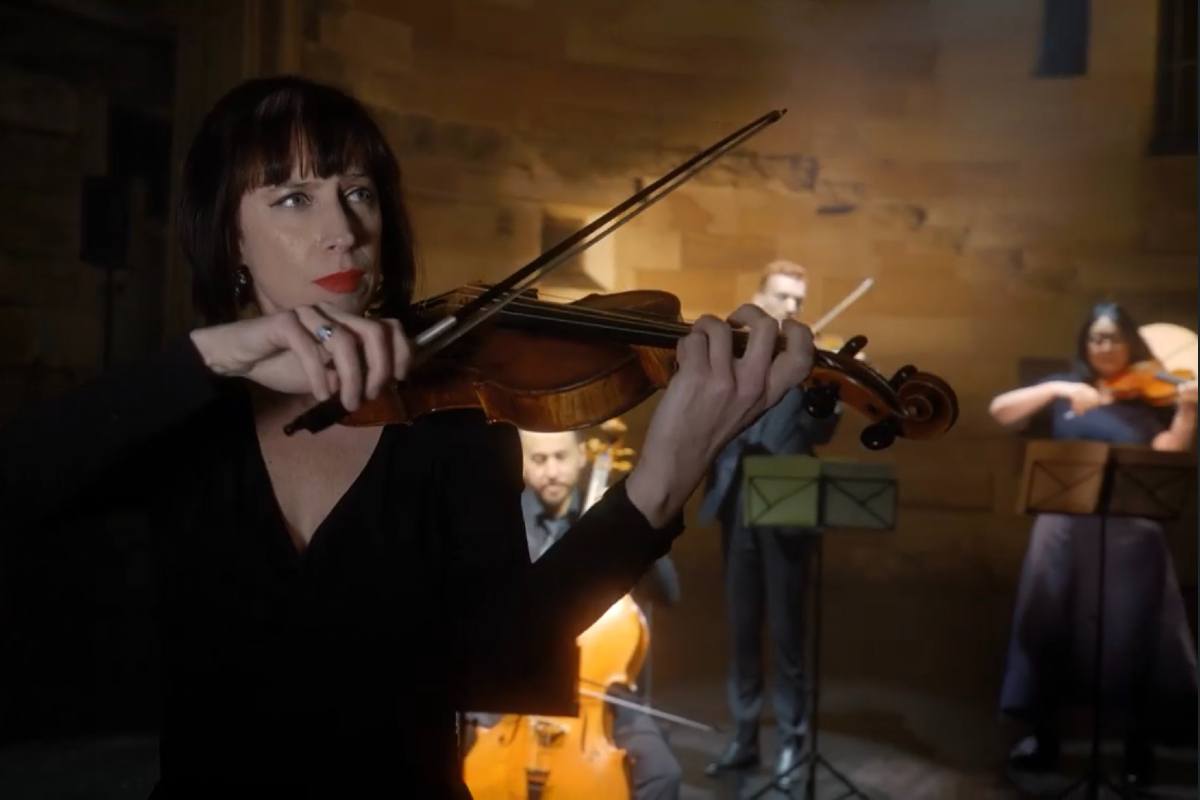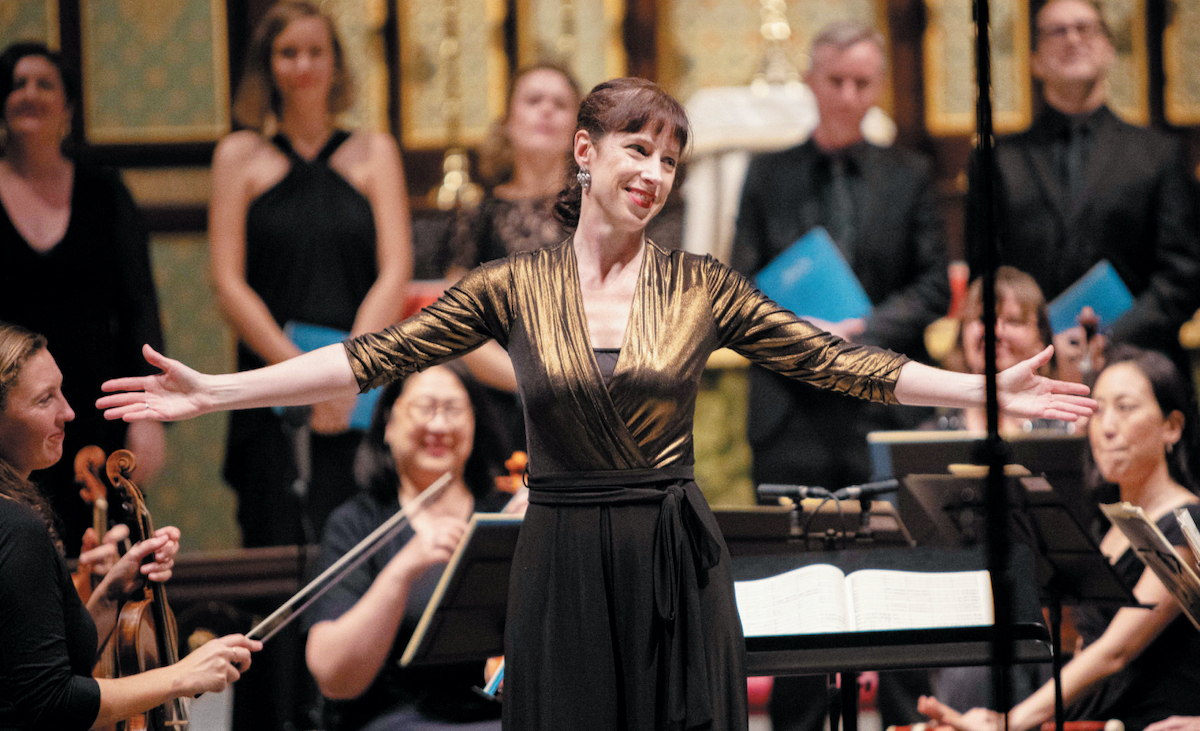You’ve written that you had an “instant connection” when you first picked up your Grancino violin. Is the spark still there?
It is very much still there! Oh my gosh, every time I pick up the instrument and do something as simple as tune it, I can hear that inner resonance, the depth of sound, the clarity and beauty of it, and it still thrills me today. It’s impossible not to marvel at the skill of Grancino in managing to create an instrument of such beauty that can still be played and enjoyed 342 years later! It is the instrument of my life. I will never part with it!

Madeleine Easton, her Grancino violin and Bach Akademie Australia at the Cell Block Theatre, 2023. Photo supplied
How do you describe your relationship? Is the Grancino your ‘other half’, your ‘partner-in-crime’?
It’s my life partner! Everyone says you just ‘know’ when you meet the right one. It was the weirdest experience picking up the violin, playing it for the first time, and experiencing a feeling of rightness, of joy deep down in my gut. It was how I had always wanted to sound like on a violin.
Singers are lucky, they have their instrument within them. We have to find ours externally. When I found it, I moved hell and high water to fundraise and set up the trust whereby I was able to buy it. When you love something that much, failure is just not an option. When I have the violin under my chin, I have a chance to express myself, and let the notes of the genius composers of the past and present flow through me in as beautiful a way as I can.
What does the custodianship of a rare instrument entail? Obviously, you can’t chuck it into the boot of the car with the shopping … but what else? Maintenance, security, insurance, travel?
It’s my constant responsibility. I know where it is at all times, and I never ever leave it in a situation where its security could be compromised. It is insured up to the hilt in all situations worldwide – which doesn’t come cheap, believe me!
I am constantly aware of the humidity and temperature of wherever the violin is, and I have it professionally cleaned and maintained in Europe at the shop it was bought at every year. They know the violin and have a relationship with it as well, so it’s wonderful to bring it back to them.
I never put in the boot in case someone rear ends the car and the violin is concertina’d, and on planes it is always put above me in the overhead locker on an aircraft and no one is allowed to put anything on top of it – no matter now determined they are.
In what ways does a historic instrument differ from a high-end modern one? Are the differences as stark as, say, between a modern car and a vintage one?
Really, the only difference between a Baroque violin and a modern violin is the setup. The actual body of the violin has not changed at all over the centuries. The violin was invented in the 1500’s as part of the viol family. When makers first hit on the shape of the violin, they tried to improve it, change it, but kept coming back to it. From the late 1500’s onwards, the violin has not changed. They got it right!
The great violins of the 17th and 18th centuries – the Stradivari, the Guanaris, the Grancinos – were all made as Baroque violins, so with a shorter, flatter neck, a flat tail piece, different bridge and gut strings. They had no chin rest or shoulder rest.
But as music changed and composers demanded more and more from their performers, or started writing in higher and higher positions, the instrument makers were forced to adapt the violin. They began making them with slanted, longer necks, adding the chin rest (in about 1820) and eventually the shoulder rest to allow for more support and ease of movement up and down the instrument.
The great violins of the past were given a sort of an operation, whereby the neck was taken off, then put back on with a new longer modern fingerboard reattached at the slanted angle and new tailpieces. This was done so these great violins were able to keep being performed on. My Grancino is no exception.

Madeleine Easton and Bach Akademie Australia. Photo supplied
When you program a concert, do you think about what Bach’s music might say to the moment? Or do you let the listener draw their own inferences?
This goes to the core of why I decided to form a dedicated Bach orchestra here in Australia. Bach saw war, plague, poverty and everything in between. What he and his generation experienced is sadly no different to what we are experiencing today. It seems human beings don’t change, and the mistakes of the past are constantly repeated. What is amazing is that in every piece of Bach, you can find something that relates to you today, no matter the year we happen to be in. I guarantee you that in the year 3025, there will be someone who listens to Bach and finds the same solace, comfort and meaning in his music as I do today.
In a way, I don’t have to explain to the listener what I see, hear and feel in his music. It will do it for you anyway. What I can do is program this repertoire, shine a light on the fact that sadly refugees have had to flee conflict for millennia, and still are.
Here is this remarkable man called J.S. Bach who wrote this masterpiece of a cantata expressing the sentiment ‘Give the hungry your bread’. Also his cantata BWV 147 ‘Herz und Mund, Tat und Leben’, which teaches us that through your heart and mind, your deeds and your life, you can live a good life. It is a universal message of love, generosity, graciousness and hope that we can take with us, and you never know, just maybe create a better future for ourselves.
Madeleine Easton leads Bach Akademie Australia in its first concert of 2024, Bach – The Benefactor, at St Francis of Assisi Church, Paddington, Sydney, 12 April and Our Lady of Dolours, Chatswood, North Sydney, 14 April.











Comments
Log in to join the conversation.